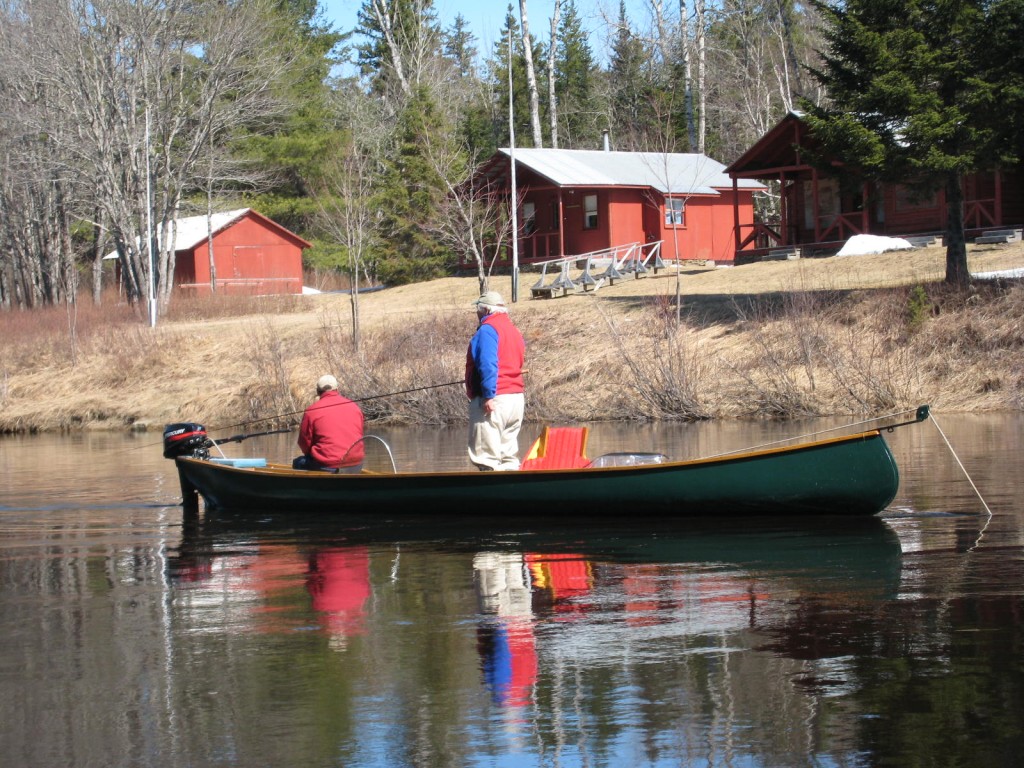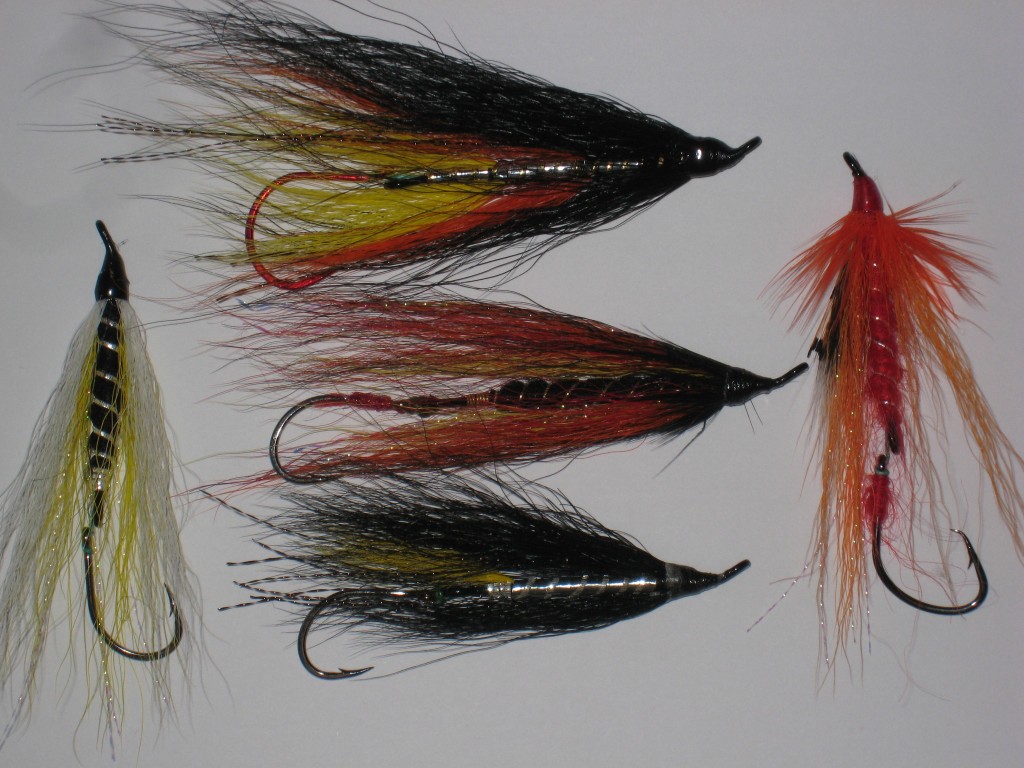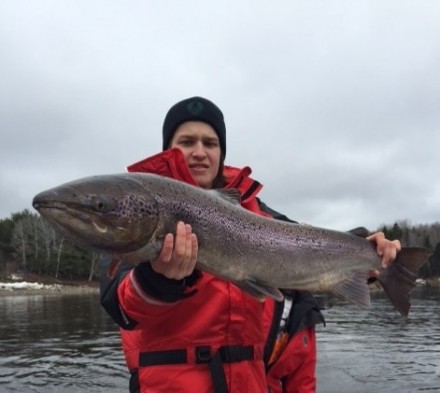
In Time of Winter Prepare for Spring – Salmon!
Early Winter Salmon Fishing Blog 2015
Over the course of the next couple of months I’m going to write four blog entries about tackle and techniques for fishing the Miramichi. I’m going to divide these up as follows: the first one that is included here will be fishing for spring salmon or kelts; this will be followed by early-run bright fish, third will be summer fishing, and last will be autumn fishing. I hope that no matter what your experience level, you will find not only a little winter entertainment, but also something useful in these articles. Perhaps they will help you prepare your tackle for next season, or give you a new idea or two on how you might approach a particular situation on the river when the salmon are running.
Spring Salmon Fishing
This fishery begins when the season opens on April 15 and continues until about the second week in May. The target fish are the salmon that spawned the previous fall and have been living under the river ice all winter. Something of a controversy surrounds spring salmon fishing. The European fishery calls these fish kelts. Here they are often called black salmon. In Europe very few fishermen target these fish. They are caught incidentally while fishing for early bright salmon, which run much earlier in many parts of Europe than they do in North America. One can go fishing for these early bright fish, called springers, and also get some regular action catching kelts. In North America we don’t have bright fish arriving in April, but the Miramichi supports the most vibrant fishery for spring salmon that exists. All of the guides who have worked at my camp on the Miramichi have done lots of spring salmon guiding, and they enjoy it. The proof of its popularity is that historically, for many lodges, a large percentage of the income for the entire season came from the brief spring fishery.
There are some salmon anglers who feel that fishing for kelts is unsporting. While it is true that the fish are not the equal of bright salmon they are still strong fish, and they are still salmon. It is easier to catch these fish, but there is still plenty of challenge. As far as the conservation arguments go, the spring fish have already spawned, and probably no more than 20% will live to make it back to the river to spawn again. That is still a very good percentage, and these are all experienced and relatively mature fish, so they are valuable spawners. In the cold water of springtime, though, the oxygen is high and if released properly – which means played firmly and kept in the water when netted – mortality is extremely low. In some cases virtually every fish of the 50 or so that are surgically operated on and have radio tags implanted each year on the Miramichi live to make it out into the open sea. You can read much more about this on the Miramichi Salmon Association website.
Unlike the bright salmon ascending the river in the summer the kelts are now feeding actively. They are in the process of rebuilding their bodies to come back up the rivers and spawn again. Depending on the food they find near the river mouths some of these fish will come back that same summer and spawn that fall. Other fish will leave the river, head to Greenland, and not come back for one or more years before spawning again. All of the largest fish found in the Miramichi, or for that matter most large salmon rivers, are reconditioned kelts.
Up inside the Miramichi there is little large forage for the kelts. I don’t know if anyone has done any analysis of what these fish are eating right after ice out, but I would guess it must be nymphs. Once the kelts get down near the estuary they run into the famous Miramichi smelt run, and it is well known that they feed heavily on this large prey species. In any case, the fish are on the feed, and generally speaking I believe that the trick is to get any large, tempting fly down to the bottom-hugging depth where the fish are hanging out.
Fishing Techniques
The need to scrape the bottom diminishes as the water warms and the river drops – thus decreasing river volume and current speed. Initially, though, you want to keep your fly very near the bottom, and ideally you want it to move very slowly. Down in the lower river a technique called long-lining was developed many years ago. Here a sinking fly line and fly are let out behind an anchored boat. In some cases the fly line and many yards of backing are all let out. Eventually the fly gets far down in the water column, and in the shifting current eddies moves back and forth across the bottom. The angler now reels the fly in very, very, very slowly. Is this fly fishing? Some don’t think so, but it is certainly effective, and it allows people who are not great casters to catch fish.
The basic technique that I use is to cast a sink tip line and fly out into the current, and then by mending line and/or steering the rod tip around with the current I encourage the fly to sink down into the water column before the line tightens. Frequently this means that rather than making a longer cast you make one that is just a tiny bit longer than the last. Then, after the fly has landed, you simply pull a little more line from the reel and feed more line into the drift as the fly sinks. When everything comes taut the fly is down in the fish market. Through mending and rod positioning I try to keep the fly from coming around too fast. Once the fly has straightened out behind the boat I will allow it to hold in position for at least 10 or 15 seconds. I then point the rod tip at the fly and pull it back towards me several times “pumping the fly”. Then I wait another 15 seconds or so before stripping in for the next cast. A very high percentage of the strikes come during this period when the fly is more or less dangling at the end of your line directly downstream from the boat.
Where to find Kelts
There is no need here to talk at length about the kind of habitat along the river that holds kelts. Virtually everyone reading this will fish with a guide, and finding the location of the fish is the guide’s most important job. For the local anglers who don’t need a guide, they probably also don’t need me to tell them where to find kelts. I will say, though, that it is in very different places than you find bright fish. Bright fish are coming upriver and will stop near structures that break up the water’s flow and make their passage easier and safer. Kelts are dropping down stream and feeding. They like places where they can easily work along the bottom and find food. In general this means along the edges of the river in slower moving water with decent depth. This area of productive habitat is normally a fairly narrow ribbon along the shoreline. Often the areas that produce kelts are dry ground in summer low water. You don’t need long casts to cover these areas, but the strike zone can run for very long distances along the shore. Getting the fly down into the strike zone and keeping it there so fish will find it an easy target is the name of the game.

Guide Jason Curtis and angler George Watson spring fishing in front of The Popples Camp on the Cains River
Gear selection
First, it is important to realize that later April and even early May can be very wintery on the Miramichi. It can also be nice and warm, but that is easy to adjust to. You should be equipped to handle wind-driven rain at up to 40 kmh at temperatures hovering around freezing. You don’t need waders, but you must have rain pant, and good boots with feet that will keep your feet from freezing when you’re standing for hours on 36-degree water covered by only a thin sheet of aluminum. Thick, warm gloves, while impossible to cast with are a terrific comfort when running between fishing areas. A large, waterproof bag is really a necessity for spring trips.
I head to the Miramichi in late April with a pair of 10-weight rods. The 10-weights are great for throwing sinking lines and big flies. Depending on water height and weather conditions I have a reel on one that has a 450 grain sink tip and a 300 to 350 on the other. I’m never without an intermediate setup also. I usually have that ready on a third reel inside that big bag. Sometimes a clear intermediate has all the sinking speed that is required. All one needs for leaders and/or tippet material is a spool of 20-pound test mono. I just cut off about six feet and call it good. The river is full of suspended material at this time of year, and the flies are large. The salmon are anything but leader shy.
Let me say that spring fishing is not the time to exercise your second-rate reels. Most of the salmon that you will catch are grilse or salmon up to about 34 inches. In slow water you don’t need a lot to handle these fish. Every now and then, though, you run into a show-stopper. My friend Duncan Barnes, long-time editor of Field and Stream Magazine, and a man with oodles of salmon fishing experience, landed the largest salmon of his life almost in front Jason Curtis’s house in Blackville one day in the early 2000s. The fish was estimated to be 49 inches long, and it ran Duncan around the river for some time before Jason could go ashore and net it. I had a similar experience around 2005 or so with Willy Bacso up at Black Brook. We finally landed the fish across the river and a quarter mile down from the BBSC lodge – it too was a 49-inch hen fish and must have weighed at least 35 pounds when it entered the river the year before.
Flies
Almost any large salmon fly will probably do. Many guides are loyal to big versions of the same flies that they use in the season for early bright fish. Classic names like a Black Ghost, Renous Special or Mickey Finn come to mind and will definitely work. Personally I like large flies with mobile wings. The teeth of the kelts are rough, though, and you are likely to hook many more in a couple of days than you would bright salmon in a season. That means that overly complicated flies, or ones made out of soft materials – like marabou – are probably not best. I take a lot of flies out with me, but my favorite flies are single-hooked – now required on the Miramichi – flies tied on Waddington shanks. I like bucktail with some flash, and I like a little color. The UK favorite Willy Gunn pattern tied with black, orange, yellow and red is one of my very favorites. I will sometimes fish an entire 3-day trip and only take off one Willy Gunn to put on a different sized or less chewed version. One of the great things about Waddington shanks or tube flies is that you can make a fly of whatever length that you want and still have a small, stout hook on the end.

Waddington shank flies. Black Ghost and Shrimp on ends, Comet, Willie Gunn, Black and Yellow top to bottom. Note these flies need to have the barbs crushed before fishing.
How and where to go
Unless you are a NB resident you will need a guide. In addition to simply being legal you need a boat to access the fishing and to get about on the river swollen by spring flow. Almost all of the regular summer outfitters like Country Haven, Wilsons, The Ledges and Upper Oxbow do a good business in spring salmon fishing. Beyond them, though, many smaller local outfitters fish only in this season when almost every camp owner that I know allows the public to fish on their private water. A few minutes on Google should turn up lots of possibilities. Generally speaking, private water is only enforced on the river during the bright salmon season from around Memorial Day onward. The kelts are long gone by that time.
There can be good to very good spring fishing almost anywhere downriver from Boiestown. Generally speaking, though, the heart of spring salmon fishing is from the mouth of the Cains down to tidewater. The later in the season that you go the further down the river you will want to be located. The best fishing ends as late as mid-May down at the head of the estuary, and the smelt-fed fish that are caught then are often well on their way to being rebuilt. Many of them will re-appear in July and August as bright fish that will spawn again that fall. These fish are called consecutive spawners.
As an introduction to salmon fishing – if you don’t mind a little cold weather – or as a chance to just get out on the river after a long winter, the Miramichi spring salmon fishery can be great way to kick off your salmon fishing season. Don’t hesitate to contact me at bigbass@maine.rr.com if you have any questions.



